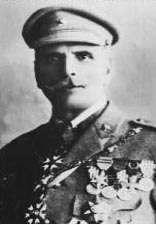Manuel de Oliveira Gomes da Costa
| His Excellency Manuel Gomes da Costa GOTE GCA | |||||||||||||||||||||||||||||||||||||||||||||||
|---|---|---|---|---|---|---|---|---|---|---|---|---|---|---|---|---|---|---|---|---|---|---|---|---|---|---|---|---|---|---|---|---|---|---|---|---|---|---|---|---|---|---|---|---|---|---|---|
 | |||||||||||||||||||||||||||||||||||||||||||||||
| 10th President of Portugal | |||||||||||||||||||||||||||||||||||||||||||||||
|
In office June 29, 1926 – July 9, 1926 | |||||||||||||||||||||||||||||||||||||||||||||||
| Preceded by | José Mendes Cabeçadas | ||||||||||||||||||||||||||||||||||||||||||||||
| Succeeded by | Óscar Carmona | ||||||||||||||||||||||||||||||||||||||||||||||
| 95th Prime Minister of Portugal | |||||||||||||||||||||||||||||||||||||||||||||||
|
In office June 17, 1926 – July 9, 1926 | |||||||||||||||||||||||||||||||||||||||||||||||
| Preceded by | José Mendes Cabeçadas | ||||||||||||||||||||||||||||||||||||||||||||||
| Succeeded by | Óscar Carmona | ||||||||||||||||||||||||||||||||||||||||||||||
| |||||||||||||||||||||||||||||||||||||||||||||||
| Personal details | |||||||||||||||||||||||||||||||||||||||||||||||
| Born |
Manuel de Oliveira Gomes da Costa January 14, 1863 Lisbon, Portugal | ||||||||||||||||||||||||||||||||||||||||||||||
| Died |
December 17, 1929 (aged 66) Lisbon, Portugal | ||||||||||||||||||||||||||||||||||||||||||||||
| Political party | Independent | ||||||||||||||||||||||||||||||||||||||||||||||
| Spouse(s) | Henriqueta Mira Godinho | ||||||||||||||||||||||||||||||||||||||||||||||
| Occupation | Military officer (General, posthumously Marshal) | ||||||||||||||||||||||||||||||||||||||||||||||
| Signature |
| ||||||||||||||||||||||||||||||||||||||||||||||
Manuel de Oliveira Gomes da Costa, GOTE, GCA, commonly known as Manuel Gomes da Costa (Portuguese pronunciation: [mɐnuˈɛɫ ˈɡomɨʒ dɐ ˈkɔʃtɐ]), or just Gomes da Costa (January 14, 1863 in Lisbon – December 17, 1929 in Lisbon), son of Carlos Dias da Costa (b. Soure, Soure, Cotas) and wife Madalena de Oliveira and older brother of Lucrécia and Amália, was a Portuguese army officer and politician, the tenth President of the Portuguese Republic and the second of the Ditadura Nacional.
He began his military career by studying at the Colégio Militar at age 10. On May 15, 1885 in Penamacor he married Henriqueta Júlia de Mira Godinho (Lagos, Santa Maria, July 30, 1863 - February 22, 1936), by whom he had three children. As a soldier he stood out in pacification campaigns in the African and Indian colonies, and also during the First World War (See: Portugal in the Great War). As a politician he was the person chosen by the right-wing revolutionaries to lead the 28 May 1926 coup d'état in Braga (after the death of General Alves Roçadas, their previous choice).

After the success of the revolution he did not assume power at first, entrusting the posts of President of the Republic and President of the Council of Ministers (Prime Minister) to José Mendes Cabeçadas, the leader of the revolution in Lisbon. Soon the coup leaders disliked Mendes Cabeçadas' attitude (which tried an approach similar to that of the late Portuguese First Republic) and he was replaced by Gomes da Costa in both posts in a meeting in Sacavém on June 17, 1926. However, his government lasted nearly as little as Cabeçadas' because on July 9 of the same year a new revolution led by Óscar Carmona overthrew Gomes da Costa, incapable of governing.
Carmona, already President of the Republic and of the Council of Ministers, sent him to exile in the Azores Islands, and made him a Marshal of the Portuguese Army. In September 1927, he returned to mainland Portugal, very ill.
He was the father in law of Pedro Francisco Massano de Amorim, Governor of Gaza, Angola, Mozambique and India.
See also
- List of Presidents of Portugal
- List of Prime Ministers of Portugal
- Portuguese First Republic
- Ditadura Nacional
- Estado Novo (Portugal)
- History of Portugal
- Timeline of Portuguese history
- Politics of Portugal
| Political offices | ||
|---|---|---|
| Preceded by José Mendes Cabeçadas |
President and Prime Minister of Portugal 1926 |
Succeeded by António Óscar Carmona |